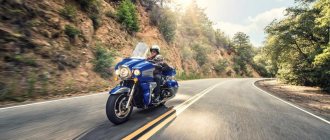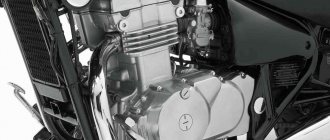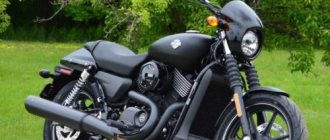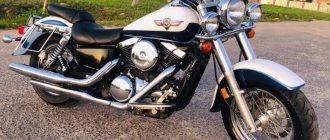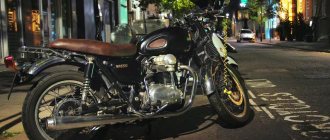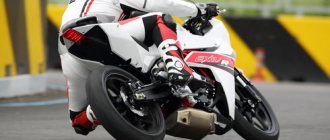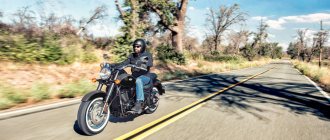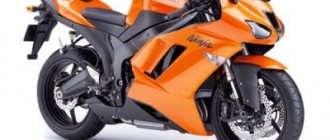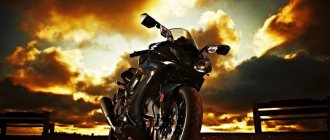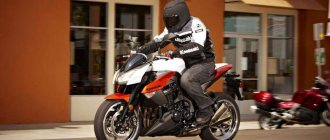This motorcycle can be called a modern classic. The alloy wheels give off some kind of sporting associations, and the colors seem to hint at his hot temperament. If you look at a motorcycle from a distance, it may even seem like a sports bike. However, at its core it is a classic cruiser.
The motorcycle is an ideological continuation of the Vulcan EN 500. Much has been improved and changed. The bike also has a second name – Kawasaki EN 650 Vulcan, which indicates its close relationship with the entire Vulcan series and continuity with the 500th model.
Specifications
In terms of its technical data, the motorcycle surpasses many bikes in its class. The Vulcan S claims to be a moderately sporty classic due to its dynamism and relative power. The filling also provides maneuverability at fairly high speeds, which will certainly be appreciated by those who crave a fast and comfortable ride.
The main idea of the famous concern was a motorcycle with a brutal exterior, similar to a power cruiser, but its filling was typical for the class. The motorcycle will be familiar to experienced users of such bikes, and will not be too difficult to control for a beginner.
Tire selection
Both of these motorcycles are built from road bikes and are not choppers in the generally accepted sense. And they got the tires from road donors, and their size too. It won’t be easy to find something classic old-school cruiser in 17” sizes, so I don’t even recommend thinking about it. Buy something sporty and touring and be happy.
For a Honda with a 17” front wheel, the choice is wide. Not so long ago, 120/70 + 160/60 was the industry standard for 600 naked bikes and supermotos. There are no difficulties with the choice. If the financial issue is not pressing, then Michelin Road 5 or the previous model Pilot Road 4 and 3, Pirelli Angel GT and ST, Metzeler Roadtec 01, Dunlop Roadsmart III. If you are pressed, then pay attention to Shinko Verge 011 or budget series of famous manufacturers: Michelin Pilot Street Radial, Pirelli Diablo Strada, Metzeler Roadtec Z 6. If you want to add a little scrambler notes to the appearance of the motorcycle, then you can look at slightly toothy tires like Pirelli MT 60 RS Corsa or Heidenau K 73 Superrain. You can also install slicks, but it will look stupid.
The Kawasaki is a little more difficult because it has an 18" front wheel. This slightly narrows the list of models available as a set. Michelin will be available Pilot Road 3 and 4, but there will be no “fifth”, or Metzeler Roadtec Z 6-Z 8 and 01, Pirelli Angel GT and ST, Dunlop Roadsmart III and the same Shinko 011. Of the “something” options “more toothy” is only the Pirelli MT 60 RS Corsa.
Remember that any modern sports-touring tires exceed the grip capabilities, both power and geometric, of these motorcycles. Don’t get hung up on searching for just one brand – there are a lot of good tires in the world, and you can always find something tenacious, long-lived and inexpensive. You just need to know what and where to look.
www.motorezina.ru is the oldest online store for motor tires in RuNet..
Aluminum marathon > September 25, 2022 11:05 Mikhail Pimus
Engine
The engine of the car is characteristic - it has two cylinders and four strokes, and its type is in-line. Why characteristic? Kawasaki in the Vulcan series has long used mainly a V-shaped version, but it was decided that this kind of engine would be more suitable.
This motor provides great capabilities. Just look at the acceleration alone: the bike can reach a speed of 100 kilometers per hour in just 4.2 seconds. Those who are familiar with the series will understand that this is a very high figure for Vulcan. In addition, the motorcycle is superior to bikes from many other brands in this regard.
The maximum speed of the car is 175 kilometers per hour. This is a good indicator for a cruiser, and allows us to talk about it as a fast motorcycle, especially taking into account its acceleration. Such successes of the model are explained by serious indicators of power and torque.
At its peak, the torque of Vulcan C is 63 newton meters. This figure is achieved at 6600 rpm. In terms of power at maximum level, the engine reaches 61 horsepower at 7500 rpm. The engine displacement is 649 cubic centimeters. These characteristics allow the motorcycle to remain one of the fastest cruisers in its weight category.
brand history
History of Kawasaki
The founder of the Japanese company Kawasaki is Shozo Kawasaki. At first it was a shipbuilding company engaged in organizing maritime transportation, as well as manufacturing aircraft and spare parts for them. After the end of the World War, the company suffered a production crisis, and only by 1950 did it begin to produce experimental engines for mopeds. And by the end of 1954, more than 200 scooters had been created. Kawasaki also began to produce bicycles with a suspended engine.
The history of the brand's production of motorcycles begins in 1961. And since 1966, Kawasaki has been trying to enter the American motorcycle market, but without success. Therefore, since about 1975, the company has been focusing on sales in the Asian market. Since that time, the brand has developed and manufactured many models of motorcycles and scooters.
Motorcycles Kawasaki VN 750 VULCAN (1986)
In an effort to create a high-performance motorcycle, Kawasaki has created a 226 kg motorcycle with a 749 cc engine capacity. It can accelerate to 153 km/h in 13.5 seconds. The maximum speed reaches 176 km/h. The braking distance of this motorcycle at a speed of 100 km/h is 44 meters. It has a 4-speed transmission, electronic ignition engine and electric starter. Engine power is 65 hp.
Motorcycles Kawasaki ER-6 NINJA 650R
In 2006, a new series of Kawasaki ER-6 NINJA 650R motorcycles went on sale. They are designed for the capricious markets of America, Australia and Europe. These models have a 2-cylinder, 4-stroke, liquid-cooled engine with digital ignition with 4 valves per cylinder and a volume of 649 cm³.
Engine power is 72.1 hp. at 8500 rpm. These models have fuel injection and a 6-speed gearbox and are capable of accelerating to 100 km/h in 3.8 seconds. Moreover, their maximum speed is 205 km/h. The fuel consumption of these motorcycles is 3.5 – 4 liters per 100 km and depends on the chosen riding style.
Motorcycles Kawasaki EN650 VULCAN S
Kawasaki EN650 VULCAN S motorcycles were developed in 2015 with an engine capacity of 649 cm³ and a power of 61 hp. They have fixed driver footrest adjustments with three positions and one-inch increments.
Bajaj Pulsar NS 200
In 2022, motorcycle lovers will be presented with the Kawasaki Bajaj Pulsar NS 200 bike with an ECU ignition system controller. It has a 4-stroke liquid-cooled engine, 4 valves and 3 spark plugs per cylinder. Engine power is 23.5 hp. at 9500 rpm. Tank capacity – 12 liters. Despite the fact that the motorcycle weighs 152 kg, it can accelerate to 100 kph in just 9.8 seconds. The maximum speed of this model according to the passport is 136 km/h. The real one, according to many users, is much higher.
Scrambler W175 (2018)
This is a Kawasaki motorcycle with a simple urban design of the W-series, having a single-cylinder air-cooled engine with a displacement of 177 cc. This model has a balancing shaft to reduce vibration levels and a 5-speed gearbox. This Kawasaki motorcycle weighs 126 kg.
Dimensions and weight
The dimensions of the bike are average. Its length reaches 2310 millimeters, its height is 1100 millimeters, and its width is 880 millimeters. Yes, you can’t call it large, but you can’t call it small either. The height of the motorcycle at the saddle is 705 millimeters. Wheelbase dimensions are 1575 millimeters.
The weight of the motorcycle is very moderate: the curb weight is 225 kilograms.
Modifications
During the production of the motorcycle there were three modifications.
- Kawasaki Vulcan VN400 A and Kawasaki Vulcan 400 B. Production of the model began with them. They existed on the assembly line for three years. 1995-1998. The first model had a belt drive, the second - a chain. A limited batch of the first ones was sent to America - but were not successful. The second model was officially supposed to remain only in Japan and in domestic markets was also designated as Vulcan II. The main difference between both versions is the Harley-Davidson Softail style design.
- Kawasaki Vulcan VN400 C (Classic). Production began in 1996. I got the same wheels 16/16 versus 21/18 for the first versions. Extended wings, like a road worker’s + a small mudguard. Black color (except for engine covers and exhaust pipes.). Produced until 2003. This and the next model already have a 14 liter tank.
- Kawasaki Vulcan VN400 D (Drifter).
If the first versions borrowed design from Harley-Davidson, this one took advantage of the developments of Indian (not to be confused with the country of the same name - the Indian Motocycle Manufacturing Company is located in the USA). Recessed fenders now cover the sides of the wheels, two muffler banks have been combined into one, and the saddle has been changed. Began in 1999, produced until production was completed. Vulcan VN400 Drifter is an Indian-style version of the motorcycle.
It is worth noting that neither the letters in the name, nor the more odious name of the third model, carried any hidden meaning.
Competitors
The model turned out to be so unusual that representatives of other American brands could not imagine an equivalent one. However, not wanting to give the entire pie (market) to Kawasaki, they offered a couple of analogues at once.
Honda
Honda Steed 400 is a light cruiser designed for American needs.
Honda offered its developments Honda Steed 400 and Honda Shadow 400.
- The first featured three valves per cylinder.
- Two carburetors.
- 10 liter tank, with a consumption of 5 liters.
- Production started in 1988.
- Closed in 2001.
The model started in 1997 and ended in 2016.
Yamaha
Yamaha XV400 Virago - a cruiser intended for the domestic market.
Yamaha's answer was the Yamaha XV400 Virago and Yamaha XVS400 Drag Star.
Interestingly, according to the developer documentation, the second is the successor to the first. Both bikes differed from the Kawasaki in that they were air cooled and had a pair (2) valves per cylinder. Both had a driveshaft, the rear shock absorber was also different. Virago had a pair of springs (versus one), the star had a rear progression. The gas tank of the first was 13 (consumption 6) liters, the second - 15 liters (consumption 3) liters. The first one started in 1987, closed in 1994, the second one opened in 1996 and existed until 2022.
Suzuki
Suzuki Intruder VS400 is a rather rare representative of serial choppers.
Suzuki did not lag behind either. For the first version, he proposed the Suzuki Intruder VS400, and for the rest, the Suzuki Intruder VL400 Classic.
- The VS400 boasted a driveshaft, a carburetor hub, and a pair of springs on the rear shock absorber. Had a 12 liter tank, consumed 4 liters. The production opened in 1994 and closed in 1996.
- The VL400 also received a driveshaft. The second generation versions were equipped with an injector. The tank is 17 liters, with a consumption of 3 liters. It is the successor to the previous model. Opened in 2001, closed in 2020.
Chassis and brakes
The tubular frame of this bike is made of high quality steel. Its design perfectly matches the character of the motorcycle and its purpose. Relief outlines emphasize the energy and speed of the car.
The rear suspension is a Uni-trak pendulum suspension equipped with a monoshock absorber. The travel of this suspension is 80 millimeters. The front suspension is a 41 mm telescopic fork with a travel of 140 mm. These suspensions maximally correspond to the tasks that the concern has set for the motorcycle.
The wheels are stylish alloy wheels that harmonize with the classic look of the bike. The steering wheel provides plenty of control over the steel monster. The rear brakes are a single 250mm disc with a single-piston caliper, while the front brakes are a 300mm disc and a two-piston caliper.
Brief history of the model
Model:
Kawasaki Vulcan S / Vulcan S ABS (all markets). Factory designation:
EN650AHF.
2015 - no significant changes.
Model:
Kawasaki Vulcan S / Vulcan S ABS (all markets). Factory designation:
EN650AFF / EN650BFF.
2016 - on all European versions of the Kawasaki Vulcan S, ABS is included as standard on the motorcycle.
Model:
Kawasaki Vulcan S / Vulcan S ABS (all markets). Factory designation:
EN650AGF / EN650BGF.
2017 - Special Edition and Cafe versions appeared.
Model:
Kawasaki Vulcan S / Vulcan S ABS, Kawasaki Vulcan S Special Edition, Kawasaki Vulcan S Café' (all markets). Factory designation:
EN650AHF, EN650CHF, EN650DHF, EN650EHF.
2018 - no significant changes.
Model:
Kawasaki Vulcan S / Vulcan S ABS, Kawasaki Vulcan S Special Edition, Kawasaki Vulcan S Café' (all markets). Factory designation:
EN650CJF, EN650DJF, EN650EJF.
2019 - no significant changes.
Model:
Kawasaki Vulcan S / Vulcan S ABS, Kawasaki Vulcan S Special Edition, Kawasaki Vulcan S Café' (all markets). Factory designation:
EN650CKF, EN650DKF, EN650EKF.
2020 - no significant changes.
Model:
Kawasaki Vulcan S / Vulcan S ABS, Kawasaki Vulcan S Special Edition, Kawasaki Vulcan S Café' (all markets). Factory designation:
EN650CLF, EN650DLF, EN650ELF.
Devices
Vulcan turned out to be quite modest in terms of instruments. The navigator has nothing to do here :). There is the required minimum, but no more. A speedometer, a couple of lights and, oddly enough (and nicely), a fuel gauge. In general, a minimal gentleman's set for every day. Everything is quite readable, but the bottom three lights should only be viewed with your head down.
In addition to the windshield and bags, the package of the “light cruiser” also includes an additional set of lamps (popularly called a “chandelier”). In fact, the pleasure turned out to be dubious, especially since one of them had already broken down (according to the seller, the bike is regularly kept in the garage for minor repairs; we’ll consider it a “feature” of the rental bike). But this is not the most interesting thing. The “lighting devices” are controlled by a button on the left of the additional headlights. Accordingly, you can turn it on only by getting off the motorcycle and pressing the button. In general, either ride “with a chandelier” or not at all, sir.
Motorcycle Kawasaki VN 650 Vulcan S 2015 Photo
Kawasaki VN 650 Vulcan S 2015 Kawasaki VN 650 Vulcan S 2015 Kawasaki VN 650 Vulcan S 2015 Kawasaki VN 650 Vulcan S 2015 Kawasaki VN 650 Vulcan S 2015 Kawasaki VN 650 Vulcan S 2015
Kawasaki VN 650 Vulcan S 2015 Kawasaki VN 650 Vulcan S 2015
Kawasaki VN 650 Vulcan S 2015 Kawasaki VN 650 Vulcan S 2015
Kawasaki VN 650 Vulcan S 2015 Kawasaki VN 650 Vulcan S 2015 Kawasaki VN 650 Vulcan S 2015 Kawasaki VN 650 Vulcan S 2015
Kawasaki VN 650 Vulcan S 2015 Kawasaki VN 650 Vulcan S 2015 Kawasaki VN 650 Vulcan S 2015 Kawasaki VN 650 Vulcan S 2015
Kawasaki VN 650 Vulcan S 2015 Kawasaki VN 650 Vulcan S 2015 Kawasaki VN 650 Vulcan S 2015
Kawasaki VN 650 Vulcan S 2015
Kawasaki VN 650 Vulcan S 2015
Kawasaki VN 650 Vulcan S 2015
Kawasaki VN 650 Vulcan S 2015 Kawasaki VN 650 Vulcan S 2015
Kawasaki VN 650 Vulcan S 2015
Kawasaki VN 650 Vulcan S 2015
Kawasaki VN 650 Vulcan S 2015 Kawasaki VN 650 Vulcan S 2015 Kawasaki VN 650 Vulcan S 2015
Kawasaki VN 650 Vulcan S 2015
Kawasaki VN 650 Vulcan S 2015
Kawasaki VN 650 Vulcan S 2015
Kawasaki VN 650 Vulcan S 2015
Kawasaki VN 650 Vulcan S 2015
Kawasaki VN 650 Vulcan S 2015 Kawasaki VN 650 Vulcan S 2015 Kawasaki VN 650 Vulcan S 2015 Kawasaki VN 650 Vulcan S 2015 Kawasaki VN 650 Vulcan S 2015
Kawasaki VN 650 Vulcan S 2015
Kawasaki VN 650 Vulcan S 2015 Kawasaki VN 650 Vulcan S 2015 Kawasaki VN 650 Vulcan S 2015
Kawasaki VN 650 Vulcan S 2015 Kawasaki VN 650 Vulcan S 2015
Kawasaki VN 650 Vulcan S 2015
Kawasaki VN 650 Vulcan S 2015 Kawasaki VN 650 Vulcan S 2015
Kawasaki VN 650 Vulcan S 2015 Kawasaki VN 650 Vulcan S 2015
Kawasaki VN 650 Vulcan S 2015
Price of Kawasaki VN 650 Vulcan S according to sales advertisements
The maximum price of Kawasaki VN 650 Vulcan S among the advertisements found is RUB 745,000*
The average price of Kawasaki VN 650 Vulcan S among the ads found is RUB 515,000*
The minimum price of Kawasaki VN 650 Vulcan S among the advertisements found is RUB 375,000*
2022 Kawasaki EN650 Vulcan S (abs) in Smolensk
11/10/2020 RUB 570,000
Kawasaki Vulcan S (EN 650) in Moscow
07.11.2020 580,000 rub.
Kawasaki EN 650 Vulcan S abs 2022 in St. Petersburg
10/30/2020 RUB 710,000
Kawasaki Vulcan S (EN650) in Cheboksary
10/29/2020 RUB 570,000
Motorcycle Kawasaki Vulcan s 650 cafe 2022 for sale in Serpukhov
10.27.2020 600,000 rub.
Kawasaki Vulcan S VN650ABS 2022 in Kazan
10/25/2020 RUB 703,000
Selling Kawasaki EN650 Vulcan S 2022 in Cheboksary
10/12/2020 RUB 599,000
Kawasaki en650 vulcan S in Komsomolsk-on-Amur
02.10.2020 490,000 rub.
Kawasaki Vulcan S Cafe EN650 in Moscow
01.10.2020 570,000 rub.
Kawasaki Vulcan S 650 black 2022 in Moscow
09/26/2020 RUB 745,000
Kawasaki vulcan 650S in Rostov-on-Don
09/18/2020 439,000 rub.
Kawasaki EN650 vulcan s 2022 in Moscow
09.09.2020 460,000 rub.
Kawasaki Vulcan 650S 2015 in Yekaterinburg
09/08/2020 479,000 rub.
Kawasaki Vulcan 650S in Omsk
09/07/2020 430,000 rub.
Kawasaki Vulcan S (EN650) ABS in Surgut
09/04/2020 380,000 rub.
Kawasaki EN650 Vulcan S 2022 in Moscow
04/25/2020 450,000 rub.
Kawasaki EN650 Vulcan S in Moscow
04/25/2020 RUB 399,000
Kawasaki EN650 Vulcan S in Moscow
01/23/2020 RUB 605,000
Kawasaki EN650 Vulcan S in St. Petersburg
11/26/2019 RUB 432,000
Kawasaki Vulcan 650 in St. Petersburg
03.11.2019 480,000 rub.
Kawasaki Vulcan S VN650 in Moscow
10/05/2019 RUB 375,000
Kawasaki EN 650 Vulcan S 2015 in Voronezh
10/03/2019 400,000 rub.
Kawasaki vulcan 650 s cafe in Pyti-Yakh
09/07/2019 420,000 rub.
Kawasaki Vulcan S650 in St. Petersburg
08/24/2019 Not specified
Kawasaki Vulcan EN650 S in Orenburg
08/20/2019 440,000 rub.
Kawasaki Vulcan 650 S in Vidnoye
08/13/2019 470,000 rub.
Selling Kawasaki Vulcan 650s 2016 in Krasnoyarsk
08/04/2019 499,000 rub.
Kawasaki Vulcan 650 2015 in St. Petersburg
07/09/2019 RUB 530,000
Selling Kawasaki Vulcan S650 in Kamenolomny
07/04/2019 450,000 rub.
Kawasaki EN650 Vulcan S in St. Petersburg
07/02/2019 450,000 rub.
Vulcan 650 S in Vologda
07/02/2019 RUB 560,000
Motorcycle kawasaki Vulcan 650 SE (EN650DA) in Surgut
06/09/2019 680,000 rub.
Kawasaki EN650 Vulcan S for sale in Moscow in Moscow
06/01/2019 RUB 399,000
Kawasaki EN650 Vulcan S (Kawasaki 650 Vulcan S) in St. Petersburg
03/21/2018 RUB 638,000
Kawasaki EN650 Vulcan S in Moscow
03/06/2018 480,000 rub.
Kawasaki EN 650 Vulcan S 2022 in Evpatoria
11/13/2017 450,000 rub.
Kawasaki EN650 Vulcan S in Moscow
08.08.2017 529,000 rub.
Kawasaki Vulcan S 650 abs 2016 in Moscow
11/16/2016 RUB 570,000
Kawasaki Vulcan S 650 abs 2016 in Moscow
09.11.2016 570,000 rub.
Selling a Kawasaki Vulcan650s motorcycle in Simferopol
06.11.2016 455,000 rub.
Kawasaki Vulcan s 650 ABS in Murmansk
03.11.2016 550,000 rub.
* Attention! Under the maximum, average and minimum of the Kawasaki VN 650 Vulcan S motorcycle on this page, the average cost according to advertisements for sale on the Internet is indicated, without taking into account the year of manufacture, configuration and generation of the motorcycle model.
Video
Kawasaki Vulcan S
— a typical representative of the modern school of motor engineering. The budget motorcycle, stylized after such “monsters” as the Harley-Davidson V-Rod and Ducati Diavel, hints with its entire appearance that it belongs to the proud family of power cruisers. True, such an impression can only be created if you look at the motorcycle in the picture. When viewed in person, the Vulcan S seems completely different, and it definitely has nothing in common with the famous Vulcan line, except for the name. This bike is a typical product of modern marketing, aimed at the widest audience of buyers. Externally modern and never classic, it has a very budget design. A proven 2-cylinder liquid-cooled 650cc engine, installed on the Kawasaki ER-6 and Kawasaki Versys 650, is inserted into the steel frame. For the new product, the engine was retuned due to lower power and higher torque - these parameters on the Vulcan S amounted to 61 hp . and 63 n.m. It must be admitted that this engine, which is successful in itself, with such settings turned out to be even more balanced and torquey. Trying to make the motorcycle both attractive and inexpensive, the manufacturer made some compromises to keep the price low. The front wheel of the Kawasaki Vulcan S has only one brake disc with a two-piston caliper, which is perhaps not enough. Fortunately, it was decided to correct the situation - since 2016, the ABS system has been included in the basic equipment of all Vulcan Ss. The suspension also lacks stars from the sky, no new products - only proven technical solutions, a telescopic fork and a short-stroke monoshock absorber at the rear with preload adjustment. The 6-speed gearbox was migrated here from donor motorcycles, and electronic injection is responsible for the fuel supply.
Since the Kawasaki Vulcan S is positioned as a cruiser, we will consider it from this point of view. Weighing less than 230kg, this model is lighter than most other cruisers, apparently due to the abundance of plastic parts that harsh chopper riders don’t like so much. However, it is unlikely that any chopper lover will be tempted by the Vulcan S, which looks not like a cruiser, but like some modern naked bike. A chain drive on a cruiser is also not a popular solution, nor is an in-line engine. Perhaps the designers remembered their models such as the Kawasaki EN 400 and ZL 400 Eliminator, but most likely they simply took the path of least resistance and took the engine that was at hand. The motorcycle is medium in size and has a close-to-cruiser stance. You can freely stretch your legs forward, and they won’t feel cramped, but you want to raise the standard steering wheel higher, even if you don’t have very long arms. The dynamics of the bike are excellent - the Kawasaki Vulcan S accelerates to 100 km/h in 4.2 seconds, and its top speed is 180 km/h. Consumption is approximately 5 liters of AI-95 during quiet driving on the highway and one and a half to two liters more in city mode.
The position of a manufacturer who wants to pass off their model as something it is not is not very clear. The Kawasaki Vulcan S is not a cruiser at all, it’s just a vaguely stylized classic road bike, and a very budget one at that. And this does not mean at all that this motorcycle is bad - on the contrary, it is inexpensive and at the same time has good characteristics. As a city bike for every day, it may well be quite popular, but fans of old-school choppers are unlikely to appreciate it.


